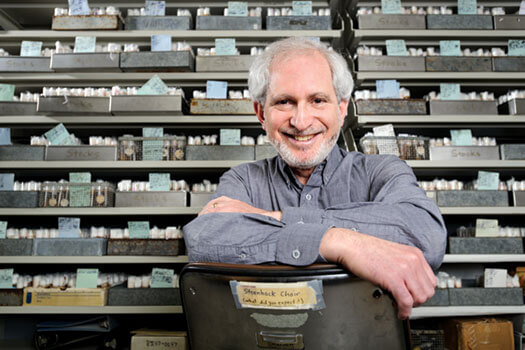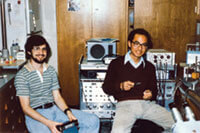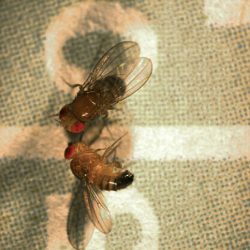Lord of the Flies

Barry Ganetzky, Steenbock Professor of Biological Sciences, sits on a chair — labeled with a bit of humor — in his unassuming lab, which is lined with shelves and trays that house fruit flies in glass vials. Photo: Jeff Miller
It all started with a dancing fly.
Barry Ganetzky perches at an old microscope, a delicate feather-tipped probe in his hand. He firmly raps an upended glass vial of fruit flies to shake its anesthetized occupants onto a plate and peers at them through the eyepieces.
It’s clear he has done this thousands of times. With a few quick flicks, the feather deftly flips and sorts tiny fly bodies into neat piles, then sweeps them into newly tagged tubes. Then he’s on to the next vial from the packed rack: flip, sort, screen, and tag — picking out differences invisible to an untrained eye.
Their size belies the magnitude of their influence: with these flies, Ganetzky, a geneticist and Steenbock Professor of Biological Sciences at UW–Madison, has improved the understanding of human conditions ranging from cardiac failures in young athletes to aging brains.
And yet, he did not set out with these goals in mind. Unlike clinical or translational research, where the direct intent is to improve health care, basic research such as Ganetzky’s aims simply to gain knowledge of the world and how it works, including the biology of the creatures living in it.
It is also the type of research so often lampooned by politicians as an example of wasteful government spending — who cares why a sleeping fly’s legs twitch? But the answer to that question has helped to explain how numerous drugs hurt the patients they were supposed to help and has permanently affected the pharmaceutical development process.
Ganetzky’s unassuming laboratory is modest compared to the rooms full of gleaming equipment just steps away in the Genetics Biotechnology Center on the UW campus. But don’t let appearances fool you. Like the flies they work on, Ganetzky and his lab team are giants in the world of science.
Broken Hearts
It all started with a dancing fly.
In the late 1960s, a geneticist named William Kaplan noticed a curious behavior in a set of fruit flies that had been anesthetized with ether. While most fell completely still, in one batch, the flies twitched their legs in response to the anesthetic, beating the air in a frenzied manner that reminded the researcher of the dancers at a nearby nightclub. The rhythmic movements led to the name ether-à-go-go but little else, and the mutant flies were shelved in favor of other pursuits.
About a decade later, Ganetzky was working as a new postdoctoral fellow at the California Institute of Technology in the lab of renowned physicist-turned-biologist Seymour Benzer, considered by many to be the founder of the field of neurogenetics. Ganetzky quickly banded together with another new postdoc, Chun-Fang Wu, hoping to use genetics as a tool to dissect the workings of the nervous system.
The goal was characteristic of Ganetzky’s approach to science, Wu recalls, saying, “He doesn’t want to join the crowd. He likes to explore new things.”
Wu’s skills in physiology and electronics complemented Ganetzky’s in genetics, and together they began measuring the electrical signals that are the currency of the nervous system, looking for flies with mutations in important genes. They realized they could use the fly’s behavior — locomotion, for example — as a readout for underlying biological problems that they could then trace back to their genetic roots.
“I don’t want to guess which genes I think are important for one thing or another. I want the fly to tell me the answer,” Ganetzky says.
And that’s something flies are able to do, provided that scientists are there to listen. Many biological processes are shared by all living organisms, from bacteria to humans. Fruit flies offer an accessible system to probe those basic questions.
“It’s not surprising that simple findings [in fruit flies] can have a profound effect in eventually understanding human disease,” Wu says.
The fly studies are not unlike human medical genetics, Ganetzky says, where patients come in with symptoms — cardiac arrhythmias, seizures, tumors — and it’s up to the doctor to identify the genes involved. “That’s exactly what I do, except I’m looking at flies,” he says. “The difference between humans and flies is that we have to generate our own patients.”
That’s achieved through a process called mutagenesis, which uses DNA-targeting chemicals to create genetic mutations randomly dispersed throughout the genome. Most have no discernible effect, but some disrupt important genes and lead to visible changes, such as leg twitches under anesthesia. The trick is then finding a way to identify the mutant genes.
Ganetzky and Wu chose heat as their screening tool. In all its complexity, Ganetzky explains, the nervous system of a mutant fly is “like a house built with defective bricks. The house stands — until it is put under stress, and then it collapses. When the temperature is raised, if there’s a weak link, the process fails.”
They began to find flies whose nerves failed under stress. These “temperature-sensitive paralytic mutants” acted normal under regular lab conditions, but became paralyzed when warmed from room temperature to about 98.6 degrees Fahrenheit.
By comparing the types of defects in neural activity, the researchers realized they were looking at mutations in ion channels, the gated pores that selectively control the inward and outward flow of the potassium, sodium, and calcium ions that carry electrical current in nerves.
Other scientists in the Benzer lab had been busy isolating the first known ion channel, a potassium channel called shaker. Here was evidence that ion channels were much more numerous and diverse than previously thought.
Trust the Flies
They moved on — Ganetzky to Wisconsin, Wu to Iowa — but continued to work with their model. Then Ganetzky began having trouble with one of his projects: following an interesting behavior had led him further away from the mutation he thought he was studying. The flies were trying to tell him something different.
Trusting the flies, he followed the behavior. Finally he realized what he was looking at: he had rediscovered ether-à-go-go, the dancing fly, and the mutated gene was a new ion channel. From that gene, he and his lab members quickly identified a whole family of related genes in both flies and mammals, including one in humans they named HERG for human ether-à-go-go-related gene.
Shortly afterward, Ganetzky described his new channels at a conference also attended by Mark Keating, a cardiologist studying a type of cardiac arrhythmia called long QT syndrome, which can lead to ventricular fibrillation and sudden death. An inherited form pointed to the same chromosome as HERG. Knowing that finely tuned ion channels also drive heart rhythms, the connection seemed clear. With help from Ganetzky’s tools, the group confirmed that HERG mutations are responsible for a form of the disease.
Though congenital long QT syndrome is relatively rare, an “acquired” form was appearing as an alarmingly common side effect of a wide range of drugs, including antihistamines, antidepressants, antibiotics, sedatives, and cancer drugs. Drug-induced long QT syndrome caused symptoms ranging from mild heart palpitations to seizures and even death.
Back in Wisconsin, Gail Robertson, one of Ganetzky’s postdocs and now a UW–Madison neuroscience professor, went to talk to a relatively new UW faculty member who specialized in long QT syndrome, cardiologist Craig January. He was intrigued, suggesting that she look at an experimental drug known to cause cardiac arrhythmias. Sure enough, it blocked the new HERG channel.
“We started looking at non-cardiovascular drugs and found they were all HERG blockers. And frequently they were more potent HERG blockers than the anti-arrhythmic drugs,” says January, a professor of medicine and co-director of the Inherited Arrhythmias Clinic at UW Hospital.
Many of these drugs were subsequently pulled from the market due to their HERG-mediated cardiac side effects, most recently the painkillers Darvon and Darvocet in late 2010. One of the most well known, the antihistamine Seldane, was very familiar to Ganetzky because his daughter was taking it.
Since 2005, the FDA has recommended screening all new drugs for HERG interactions. Routine screening of potential drug compounds has grown into a multi-million-dollar global industry, January says, including until recently at Cellular Dynamics International, a Madison start-up founded by UW stem cell pioneer Jamie Thomson with January and UW cardiologist Timothy Kamp.
“There’s something about the HERG channel that makes it uniquely sensitive to drug block. … This became a huge issue in the drug-development world,” January says, estimating that several dozen to hundreds of pharmaceutical compounds in various stages of clinical development, and tens of thousands at preclinical stages, have failed due to HERG-blocking properties and drug-induced long QT syndrome.
While HERG was busy making headlines and shaking up the pharmaceutical industry, Ganetzky was back in his lab. HERG and its related channels had confirmed the power of his approach to uncover very fundamental, very relevant biological processes.
It was time to look at more flies. He wasn’t quite sure where they would lead him, but he was never one to pass up a challenge.

Early in their careers, Barry Ganetzky, left, and his colleague Chun-Fang Wu worked together to explore the genetics of the nervous system by looking at a fly’s behavior. It was the start of an approach Ganetzky continues to follow today, saying, “I want the fly to tell me the answer.” Courtesy of Barry Ganetzky
Forging a Path
Ganetzky grew up in Chicago, raised by a homemaker mother and an immigrant father who supported the family by working as a candy salesman. The young Ganetzky was intensely curious and was constantly asking questions, but was rarely satisfied with the responses. Even as a child, he was drawn to biology and the natural world, because he could start testing things to find his own answers.
Ganetzky’s parents were strong advocates for education, and he became a first-generation college student at his hometown school, the University of Illinois at Chicago. It was a commuter campus then, and he had to ride three buses to get to school each day.
He studied chemistry, he recalls, “not because I had any particular love of chemistry, but I liked science, and chemistry seemed marketable. I didn’t think biologists were employable.”
He initially turned down a spot in an honors program, thinking that it just sounded like a lot of extra work. But after a couple years of scrabbling for classes that fit around his onerous commute, he reconsidered when he learned that honors students got priority registration. The about-face was a momentous decision.
To fulfill his honors requirement, he approached a young genetics professor, Michael Cummings, and started a ten-week research project on early development of fruit flies.
It was a revelation. Here, the qualities that had caused friction in his youth — questioning authority, challenging others’ answers — were encouraged in the pursuit of new knowledge. “For the first time, here was a suit of clothes that fit,” he says, the relief still evident in his voice even decades later.
Ganetzky declared biology as his major, and the ten-week study quickly grew into a two-year labor of love. Inspired by his first academic role model, he applied to graduate school and, that fall, he crossed the Mississippi River for the first time in his life en route to the University of Washington in Seattle.
Knowing that many scientists were beginning to think that fly genetics had passed its prime as a discipline, Ganetzky arrived on the West Coast eager to change directions and delve into the burgeoning field of molecular biology — the study of DNA and other nuts and bolts of biological systems. Fruit flies were no good for that sort of thing, he thought. They are too complex, too unwieldy.
But a last required course during summer term in Illinois put him in Seattle later than his new classmates, and the research positions he thought he wanted were already taken. Somewhat disappointed, he checked out a couple of the remaining labs, including a fruit fly genetics lab run by Larry Sandler.
“It was a fluke that I ended up there, but from the moment I set foot in that lab, I knew this was special,” Ganetzky says. Sandler liked to challenge his students to conduct elaborate thought experiments, working through a dizzying array of research designs, outcomes, and interpretations before so much as lifting a pipette. Ganetzky excelled at the intellectual exercises, which helped him find the best — and often the simplest — ways to answer questions.
“The basic principles of genetics are pretty simple. Take the right male and the right female, put them together, and collect the offspring,” he says. The art, he adds, is in choosing Mr. and Mrs. Right and deciding how to set up the crosses.
He’s being modest, of course. In reality, the path from finding an interesting behavior to identifying the gene responsible for that behavior can be rocky, convoluted, and very, very long. It typically involves breeding flies that have a trait of interest with lab flies engineered to carry particular markers in their DNA. Geneticists rely on a process called recombination, in which chunks of DNA swap, or recombine, between pairs of chromosomes, mixing up the DNA from mom and dad. By crossing the right flies, they can create offspring that carry both a traceable landmark and the mutation of interest.
And there are other complications. Recombination happens somewhat at random in the genome, so researchers have to cross and screen a lot of flies to find the few with the desired genetic combination.
And Ganetzky has.
He joined the UW–Madison faculty in 1979. Working just a few hundred miles from his urban, blue-collar hometown, Ganetzky has established himself as a leading and highly lauded geneticist. In 2006, he was inducted into the National Academy of Sciences, a select group of the country’s top scientists hand-picked by their peers. He’s come a long way from the young graduate student who was awed by the “genetic endowment” of his peers (one classmate was the daughter of a Nobel Laureate) and worried that he couldn’t compete.
“Over the years in science, I’ve come to realize that so much of it is salesmanship — grant applications, giving seminars, writing papers, presenting your work,” he muses. “And I’ve come to realize that I probably got something even more valuable from my father.”
Old Flies, New Tricks
Thirty years in, Ganetzky is still listening to his flies and still discovering basic — and unexpected — biological answers.
Though many senior professors transition into primarily administrative roles in their labs, Ganetzky still spends time at the bench and maintains his own fly stocks, a practice that led to his newest interest. Tending to some flies behind schedule one day, he noticed a few that, despite being perfectly healthy just a week or two earlier, looked a bit off: sluggish, uncoordinated, less responsive, old.
It made him think about aging and dementia. Sure enough, when he and his lab staff started looking more carefully, they found flies with signs of neural degeneration, the process underlying Alzheimer’s, Parkinson’s, and numerous other human diseases. At first glance, one of the most interesting was a mutant fly they named wasted away after its Swiss-cheese brain and early death. But when then-graduate student Joshua Gnerer PhD’08 isolated the gene that was responsible, they were disappointed.
The common metabolic enzyme triosephosphate isomerase, or TPI, was well known to biochemists for its role in breaking down sugars to produce energy, but it was certainly “not one that anyone would have picked out to study with respect to neurodegeneration,” Ganetzky says. It made no sense, since defects in other steps in the same process did not cause the same neural degradation. But the sick flies were clearly telling them that this enzyme was important, that somehow it was different.
Delving deep into the scientific literature, Gnerer found an intriguing link: human TPI deficiency causes severe neurodegeneration and childhood death. Back in the lab, the researchers homed in on TPI’s activity and discovered that it prevents the buildup of a highly toxic metabolic byproduct, a molecule called methyl-glyoxyl that disrupts proteins and gloms them into sticky clumps that kill cells.
TPI deficiency in humans is very rare, and this discovery will only have limited direct impact on human medicine, Ganetzky says. But it presents a novel paradigm that is likely the tip of a new iceberg; what was dismissed as a ho-hum metabolic enzyme also has a neuroprotective role, and it probably isn’t the only one.
It’s especially intriguing because these protein clumps have been linked to every other common neurodegenerative disorder, as well as inflammation and diabetes, he says, “and we’re in a position — because we can manipulate the flies — to [study it].”
While Ganetzky is excited about the clinical relevance of the new findings, he firmly believes that studies that don’t appear to have a direct path to human medicine lay a crucial groundwork for making, recognizing, and understanding the discoveries that follow.
“This all began with such basic things,” he says. “If it weren’t for step one, I wouldn’t have gotten to two; and if it weren’t for step two, I wouldn’t have gotten to three; and so on. All these things, tracing back … someone could have said, ‘Well, this seems rather esoteric and doesn’t relate to human disease.’ And they would have been right.”
It’s critical to cast a wide net, Ganetzky adds, because you never know which ideas will turn out to be the big ones. Only a fraction may lead to a big payoff, but in his experience, sometimes the most unexpected are ultimately the most interesting. Narrow your net prematurely, and you risk missing what you’re really looking for, he cautions.
Looking back, he marvels at the path he has traveled and how far he has come. “The best things that have happened to me in my career were things that weren’t deliberately planned or were planned for some other reason than how they turned out,” he reflects. “If it hadn’t been for those three bus rides, some of this may not have turned out the way it did.”
But this much is planned: he intends to keep letting the flies guide him toward important answers. He’ll continue to flip, sort, and tag, looking for the next right male and right female who have more to teach us about ourselves.
Jill Sakai PhD’06, a science writer for University Communications, values fruit fly contributions in the laboratory, but is less enamored of them in her kitchen.
Published in the Spring 2012 issue



Comments
Ricki Lewis March 25, 2012
Wonderful article! I am a former Drosophila geneticist who turned to a writing career because I did not feel a strong enough connection to the human condition, working with flies that had legs growing out of their heads and mouths. While I am happy with my career change, I was so wrong! This terrific article proves it. And I’ve come full circle — I wrote the news releases from the Drosophila meetings in Chicago a few weeks ago.